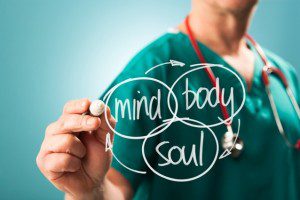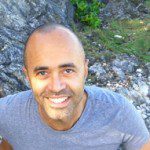Guest writer for Wake Up World
Countless people who have suffered from years of pain, discomfort, and limited physical ability have found complete healing through mind/body re-education. Many of these people have seen resolution in remarkably short periods of time.
Medical doctors such as John E. Sarno (author of Healing Back Pain, The Mindbody Prescription, and The Divided Mind) and Lissa Rankin (author of Mind Over Medicine: Scientific Proof You Can Heal Yourself, and The Fear Cure) have documented case upon case of people who have healed various illnesses through re-education and psychologically-based means. Norman Cousins, former Adjunct Professor of Medical Humanities for the School of Medicine at the University of California, chronicled his own healing from a rare and deadly form of arthritis without the use of drugs in his book Anatomy of an Illness as Perceived by the Patient: Reflections on Healing. Further, people such as Fred Amir (author of Rapid Recovery from Back and Neck Pain) have detailed their personal journeys from illness to health, again through applying the correct information to the way they live and think.
[pro_ad_display_adzone id=”110028″]
In 2004 I myself recovered from debilitating back pain which had left me walking slowly with a cane and not being able to sit for more than 5 minutes. Now I can easily take a 900 minute flight from Tokyo to Toronto. My pain had lasted years and was resolved within weeks.
Now, 10 years after my own healing, it’s time I shared some of what I have learned and experienced first-hand.
Illnesses Caused by the Mind
Many of us are aware that stress is related to several disorders such as gastrointestinal problems, headaches and heart disease. This is a widely accepted example of the relationship between the mind and the proper or improper functioning of the body. Another basic example is getting flushed when embarrassed or sweating when we are nervous. It is clear that these harmless temporary effects are caused by the mind.
The “nocebo effect” refers to the mind’s ability to cause more harmful physical disorders. Dr. Bernie Siegel cites a finding in his book Love Medicine and Miracles concerning patients in an experimental control group for a new chemotherapy drug. It is commonly known that hair loss is a side effect of chemotherapy. This group was only given harmless saline, but thought they may have been given chemotherapy. 30 percent of this group lost their hair. Yes, the mind can cause extreme physical changes in the body.
Why the Mind Creates Physical Symptoms
The above example of the nocebo effect can easily be traced back to the conscious belief that chemotherapy causes hair loss. We consciously believe something about the body and it happens. This can be said about the conditioning involved in allergies and some forms of chronic pain. We believe something causes our condition and it does!
Concerning the onset of allergies and pain not directly linked to a physical event, several authors on the subject of mindbody disorders have mentioned that the mind creates physical symptoms to distract from psychological issues. In the book Heal Your Body, Louise Hay writes “I’ve learned that there are really just two mental patterns that contribute to dis-ease: fear and anger“. It is important to note that these often do not refer to conscious fear and anger, but to deeply repressed unconscious versions.
Dr. John Sarno often speaks of profound rage. This deep-seated rage is seen by the subject as too dangerous to be brought into the conscious mind. Borrowing the term from Freud, Sarno concludes that the ego refuses to accept this emotion and creates distractions in the form of physical pain, compulsive behaviour and less threatening emotions. Some examples of this could be irritability, impatience, conscious anger or depression as emotional distractions. In working with my clients I have seen compulsive eating connected clearly. Just a few in the seemingly endless list of possible physical distractions include back and shoulder pain, allergies, eczema, tinnitus, prostate problems etc.
 Perfectionists and Good People are Especially at Risk
Perfectionists and Good People are Especially at Risk
Both Sarno and Freud refer to the battle between our basic, primitive self, only concerned with pleasure and fulfillment of desires and our more socially acceptable self which strives for perfection and advancement, or even just to be “good people” (the “id” versus the “ego” as termed by Freud). At one level we want to serve and be seen favorably by others whereas at another basic level, the selfish child in us just wants whatever s/he wants, no questions asked. This is seen to be a great producer of unconscious rage. We may strive to be good parents or partners but deep down just want to lie around, be fed our favorite food and receive massages! The child in us can have “temper tantrums” at an unconscious level and instead of allowing them into our conscious mind, our “well-adjusted” adult self unconsciously decides it is unacceptable to feel the rage. These intense feelings have to come out somehow, so they are redirected to the mind in the form of other less-threatening conscious emotions or to the body as physical symptoms.
The Mind Can Heal the Body
I will briefly discuss two different possibilities here:
1) How being 100% convinced that healing has happened or is underway equates to actual healing.
2) How chronic pain can be relieved by allowing repressed emotions into the conscious mind.
Contrary to the nocebo effect is the placebo effect. This describes the situation when a patient’s healing cannot be attributed to the properties of a treatment given to them, but only to their belief that they will be healed. Basically when people are cured just because they are sure they will be cured. In the New England Journal of Medicine, a study by Dr Bruce Moseley (1), orthopedic surgeon concerned a group of patients who underwent knee surgery and a control group that were only sedated and told convincingly that they had received the surgery. The study revealed that 1/3 of patients that did NOT receive surgery experienced a RESOLUTION of knee pain. As Dr Moseley was highly renowned for effective surgery, the placebo was particularly strong. The patients strongly believed they would be healed and they were; just because of their belief or faith.
Sometimes the placebo is temporary and pain comes back either in the original location, or another one. If the pain or condition actually has its origin in repressed emotions, the subject must be made aware that the pain is of psychological nature and that there is actually nothing seriously wrong with the body. It is important to note that emotionally based pain (psychosomatic pain) often does actually cause physical changes in the body. For example Sarno refers to measurable restrictions in blood flow to the painful area. During one phases of my illness I had extreme redness and excruciating pain in one eye. Although these are physical disorders, they can be brought back to a normal state with the mind. Once the subject realizes and FULLY accepts that the actual/original problem is not in the body, the physical symptoms disappear. It is clear then that faith and conviction are indispensable in mindbody healing.
[pro_ad_display_adzone id=”110030″]
9 Important Steps to Heal the Body Naturally, With the Mind
In his book Letting Go, The Pathway to Surrender, David Hawkins reveals how he used psychological techniques to heal himself of allergies, dermatitis, recurring colitis, low back syndrome, a pilonidal cyst at the base of his spine and a host of other disorders.
In my case, and those of people I have worked with with back problems, various skin and mucous membrane ailments and allergies, the following elements have been essential:
1. Proper diagnosis from a health professional to help you understand what the situation is in the body.
2. Education concerning the reality of healing with the mind. When we see that others have done it we are more open to believe that it’s possible for ourselves.
3. Believing that you can heal yourself and having the courage to go forward. After reading about the success of others, you decide that you too will succeed.
4. Addressing psychological dissonance. This could be caused by basic personality characteristics such as perfectionism, self-criticism etc and exacerbated by life pressures. Alternatively there could be a past trauma implicated. Having professional help can aid in uncovering and resolving this.
5. Reprogramming the mind and breaking the conditioning which perpetuates the problem. Going back to the nocebo effect, if we believe we have a chronic problem, we have a chronic problem. If every time we feel the pain, we give it less and less importance, it will lose its intensity and power over our lives.
6. Rewards for following the course and noticing positive results. The more positive we feel about each step in the healing process, the faster and more complete the healing will be.
7. Enjoying life, laughing and doing as many of the things that you love as possible.
8. Maintaining a healthy body with proper exercise (yoga, aerobic activity etc), breathing and eating. Important note: This is NOT to treat a particular part of the body, but is to work and support the body as a whole and to foster confidence in the body. Being confident that you indeed have a healthy body creates positive conditioning.
9. Maintaining a healthy mind with positive thinking, stress release, relaxation, yoga, meditation and regular contact with deep feelings.
To your health!
Paul
Article sources:
- John Sarno’s books: browse all titles here on Amazon
- Lissa Rankin’s books: browse all titles here on Amazon
- Dr. David Hawkins’ book: Letting Go, The Pathway to Surrender
- Paul Brundtland’s book: My Lasting Relief from Chronic Pain
- Norman Cousin’s book: Anatomy of an Illness as Perceived by the Patient: Reflections on Healing
- Fred Amir’s book: Rapid Recovery from Back and Neck Pain
- Dr. Bernie Siegel’s book: Love Medicine and Miracles
- Louise Hay’s book: Heal Your Body
- Sigmund Freud’s book: The Ego and the Id
- Dr. Bruce Mosely / Baylor College Of Medicine: Study Finds Common Knee Surgery No Better Than Placebo
- Melinda T. Willis MD: Knee Surgery No Better Than Placebo
- Melinda T. Willis MD: Study: Placebo Alters Brain Function
Further articles by Paul Brundtland:
- Breakups, Backaches, The Beatles, Buddha and the Brain
- Waking? Insomnia? Simple Tips to Help You Fall Back to Sleep
- Perfectionism and Fear: The Emotion Behind Getting it Just Right
About the author:
Paul Brundtland is a mind/body educator, coach and writer living in Montpellier France. Combining his own healing experience with university studies in psychology, yoga teacher training, and 10 years of independent research, Paul has coached many people through issues such as chronic back and neck pain, allergies, skin problems, eating disorders, general tension and compulsive negative thoughts. “I work with people to help them rid themselves of mental and physical blocks that impede their best functioning. Once removed, the body and mind begin to act as they naturally are designed to”. Author of the short book My Lasting Relief from Chronic Pain, Paul offers private coaching (in English, French or Spanish) as well as group mindbody training sessions.
Connect with Paul at www.paulbrundtland.com and Facebook.com/PaulBrundtland, or email Paul at [email protected].
[pro_ad_display_adzone id=”110027″]








